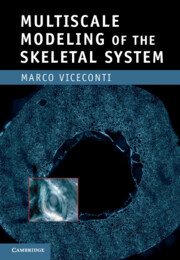7 - Applications of multiscale modeling
Published online by Cambridge University Press: 05 January 2012
Summary
Two real-world clinical applications of the multiscale modeling of the skeleton are described: one in pediatric skeletal oncology, and one in the prediction of the risk of fracture in osteoporotic patients.
Introduction
The scope of this chapter is to show, using a few clinical applications as supporting examples, how our ability to model musculoskeletal pathophysiology at different dimensional and temporal scales – as described in detail in the previous chapters – can be used to form multiscale models.
Whereas the previous chapters focused on explaining the physiological mechanisms that emerge at each scale, and the modeling methods involved, here we shall look at the practicality of composing multiscale models, indentifying the necessary set of parameters, and generating predictions that are of clinical relevance. Thus, our perspective will be much more methodological. This could condemn this chapter to a rapid obsolescence: the massive research effort on the development of the VPH framework of methods and technologies will change the way we do clinical multiscale modeling in the near future. Still, while the solutions (or their lack) described here will hopefully become obsolete, the problems to be solved will remain valid in years to come. Thus, I shall focus more on the problems than on the solutions, referring to specialized literature for the best practical approach to solve each problem to date.
- Type
- Chapter
- Information
- Multiscale Modeling of the Skeletal System , pp. 154 - 172Publisher: Cambridge University PressPrint publication year: 2011



